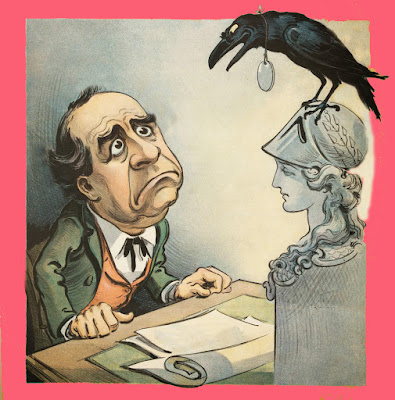I found
an article posted on December 13th by Peter Khoury at the
Magnetic Speaking blog titled
7 Unbelievable “Fear of Public Speaking” Statistics. It is so far off the mark that I want to just put my head in my hands, like the old man shown above in a
drawing by Van Gogh. Peter says that:
“There is a number floating out on the web stating that 75% of the population have speech anxiety. I have to admit, that I fell for that number at some point. But coming from an engineering background, I wanted a source to verify the information and I could not find any. That’s what started me on the quest to look into this and provide accurate data. The 75% number is wrong - real numbers are below with backed up studies to support them.”
I also thought that that 75% was wrong, but tracked it down as described in a February 3, 2014
blog post titled
Busting a myth - that 75% of people in the world fear public speaking.
Peter begins by claiming that:
“Public speaking fear (Glossophobia) is a subset of social anxiety disorder (SAD). There is a lot of misinformation out there about this fear and the number of people suffering from it.”
It isn’t a subset. Not all people who fear public speaking have social anxiety disorder (aka SAD, also known as social phobia). Back on October 11, 2011 I
blogged about What’s the difference between a fear and a phobia?
A phobia is more severe - it is an excessive, persistent, and interfering fear. The conceptual difference is shown above in a Venn diagram. (A previous version of the diagram was in
another blog post of mine from December 11, 2013 titled
Spouting Nonsense: July 2013 Toastmaster magazine article fumbles fears and phobias). Later I’ll get back to the numbers from the magazine article discussed in that post about a survey known as the NCS-R (which is from a more recent survey than the NCS Peter refers to).
Peter spreads misinformation. He looks up some statistics on social phobia and ‘adjusts’ them to supposedly describe fear of public speaking. First he looks at Table 1 in a magazine article from 1999 by T. Furmark et al. titled
Social phobia in the general population: prevalence and sociodemographic profile. For Sweden, a total of 15.6% have social phobia. He multiplies this by 0.894 to get that 13.5% of Swedes fear public speaking. (The multiplier came from an article on epidemiology of social phobia which had studied people around Florence, Italy). That is ludicrous. Back on March 25, 2011 I had blogged about the Furmark et al. article in
a post titled
Almost 1 in 4 Swedes fears public speaking. As the title suggests, Table 4 of the article instead lists their survey result that 24% fear Speaking (or performing) in front of a group of people.
Peter also looks up some results for the USA from Table 1. A total of 7.9% have social phobia. He again ‘adjusts’ - multiplies this by 0.894 to get that 7% of us fear public speaking. That 7.9% he used comes from the National Comorbidity Survey (NCS), but it only refers to a one year period. For a lifetime the prevalence (also shown) is 13.3%. Why did he choose to use the smaller number? Back on July 22, 2011 I
blogged about Putting the fear puzzle pieces together: social and specific fears in the National Comorbidity Survey. In that post I charted NCS results that Public speaking was feared by 30.2%, and Talking in front of a small group by 15.2%.
How about results from the more recent National Comorbidity Survey - Replication (NCS-R)? The article I referred to in my October 11, 2011 blog post had results for both fears and phobias. 24.1% had a social fear, and 21.2% had a fear of public speaking/performance. 12.1% had a social phobia, and 10.7% had a phobia of public speaking/performance.
What about similar statistics for other countries? On August 15, 2012 I
had blogged about how
Surveys show that public speaking isn’t feared by the majority of adults in nine developed and eleven developing countries. For 9 developed countries,15.9% had a social fear, and 13% had a fear of public speaking/performance. 6.1% had a social phobia, and 5.3% had a phobia of public speaking/performance. For 11 developing countries, 14.3% had a social fear, and 9.4% had a fear of public speaking/performance. Just 2.1% had a social phobia, and 1.6% had a phobia of public speaking/performance.
Peter pointed to some results about the effects of social phobia described in a publication from Columbia University, but didn’t bother find the actual source. It really is an article by David J. Katzelnick et al., titled
Impact of Generalized Social Anxiety Disorder in Managed Care, Am. J. Psychiatry, 2001, Vol. 158, pages 1999-2007. You can find the
abstract and download the
full text.
Peter states the following seven
Unbelievable Statistics [with my comments in brackets]. None of them are believable. If you want to read about real research, then please look elsewhere.
Overall numbers for the USA:
1] 7% of Americans fear public speaking [wrong! The NCS has 30.2%, and the NCS-R has 21.2%]
2] 6% of male Americans have speaking anxiety [wrong! The average from the NCS-R for public speaking/performance phobia is 10.7%]
3] 8% of female Americans have speaking anxiety [wrong, see above]
Negative impact of public speaking fear on career statistics:
4] Public speaking fear has 10% impairment on wages [Wrong! This percentage applies to social phobia]
5] Public speaking fear has 10% impairment on college graduation [Wrong! This percentage applies to social phobia]
6] Public speaking fear has 15% impairment on promotion to management [Wrong! 14% applies to social phobia]
How many seek professional help?
7] Only 8% of those who have public speaking fear seek professional help despite the documented negative impact on career and wages. [Wrong! That percentage only applies to people with social phobia.]




























